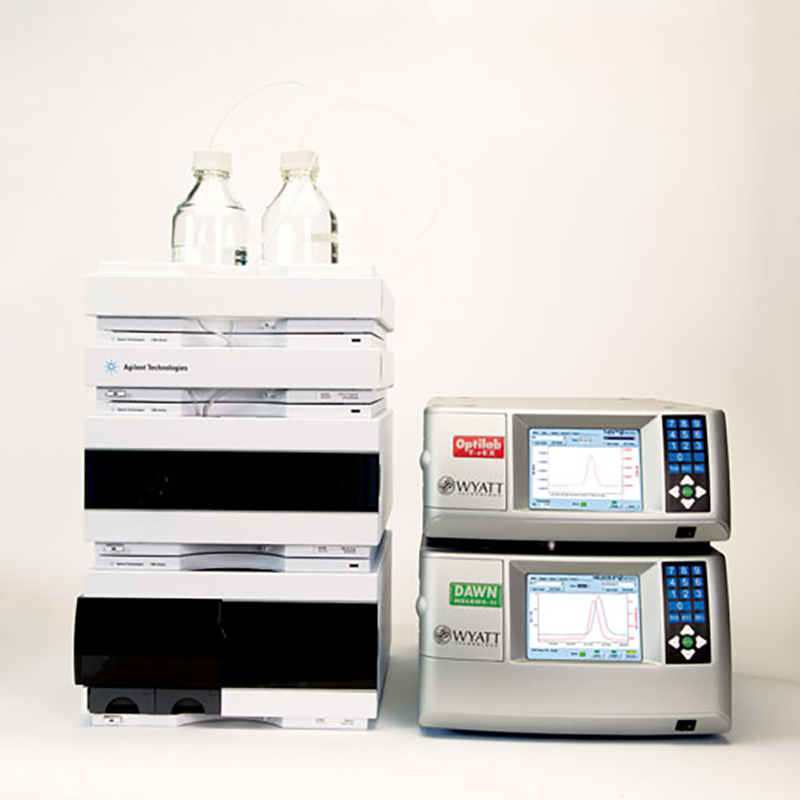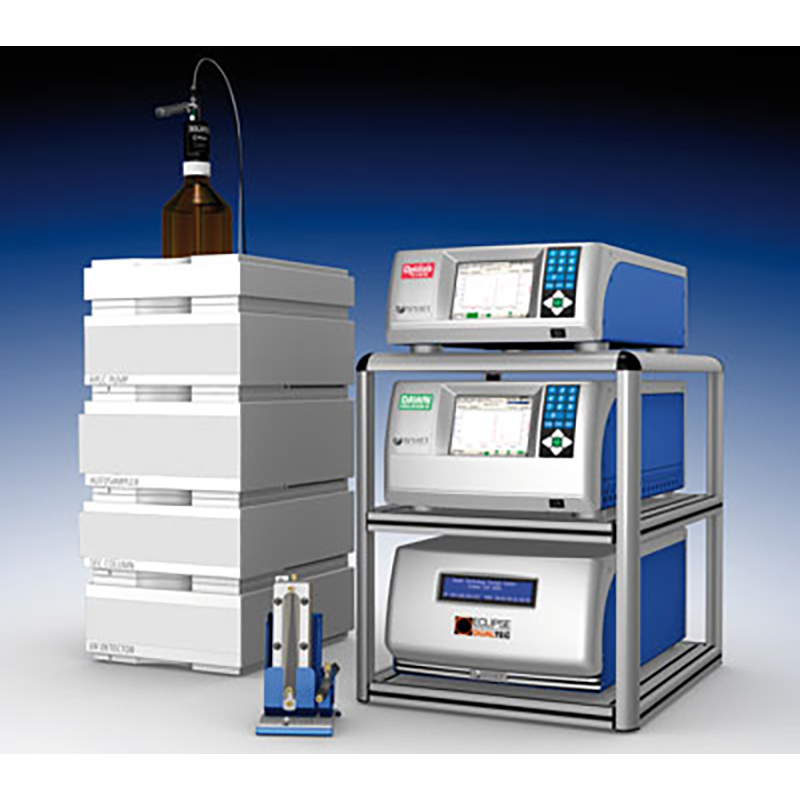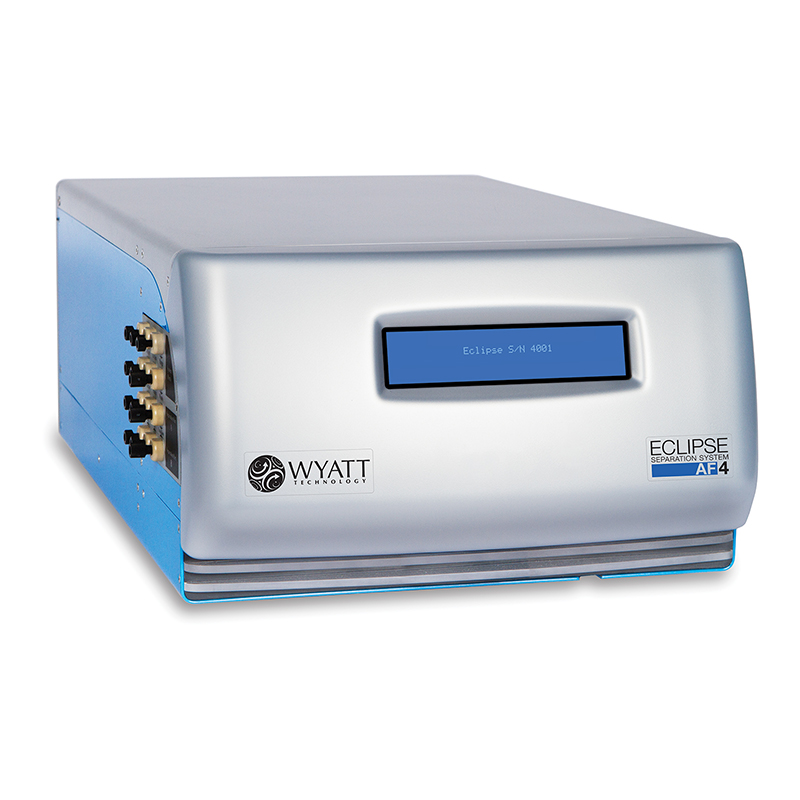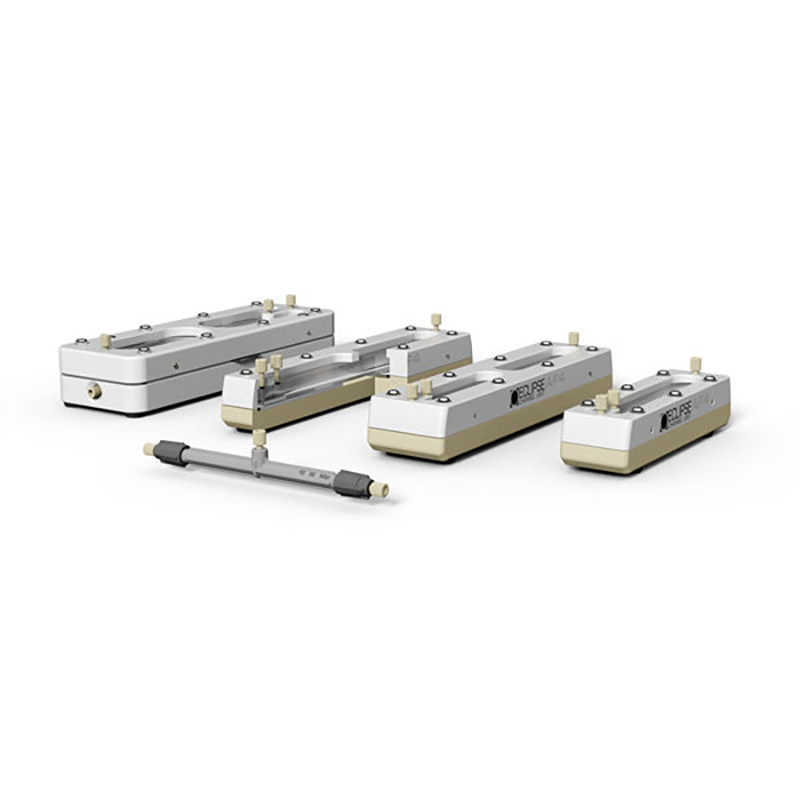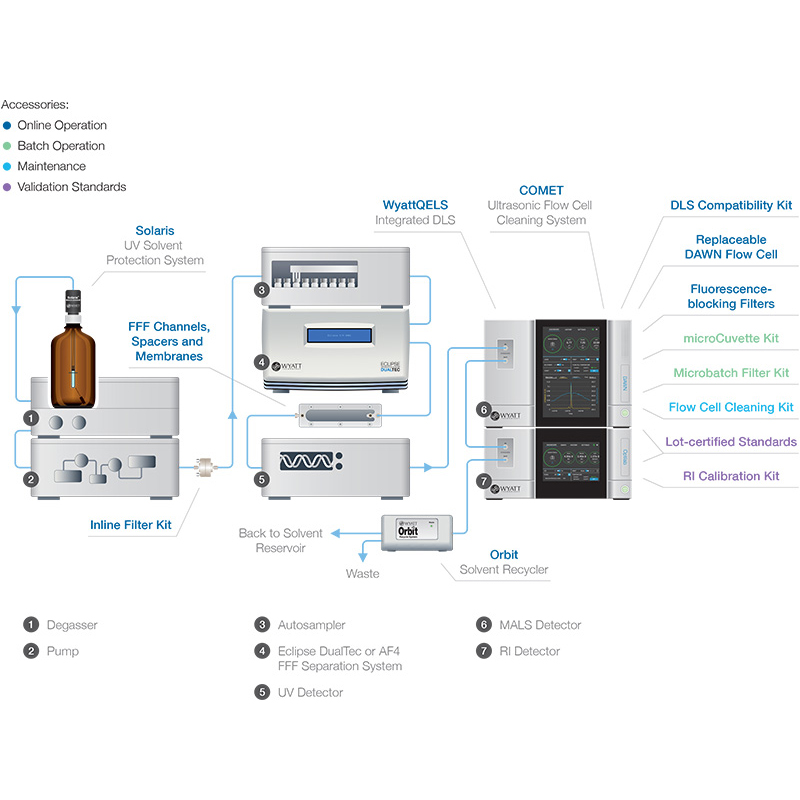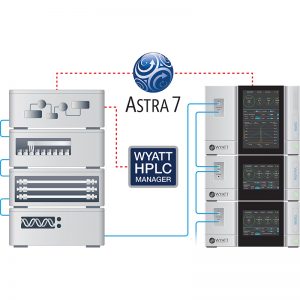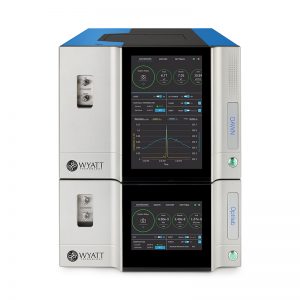Description
Uniquely Versatile
Flow Field-Flow Fractionation is a uniquely versatile means of size-based separations, capable of fractionating and characterizing proteins and aggregates, liposomes, emulsions, viral particles, polysaccharides, nanoparticles, polymer latex particles, colloidal soil suspensions, chemical mechanical polishing slurries, and many more – with no stationary phase and almost no shear.
AF4 Techniques
The Eclipse AF4 combines with a DAWN MALS detector and Optilab dRI detector to solve the most difficult separation, fractionation and sizing tasks in the macromolecular and colloidal arenas including polymers, biotechnology, pharmaceuticals, nanotechnology and environmental analysis.
Macromolecules
The advantage of AF4 over traditional SEC column chromatography is the ability to separate both soluble and colloidal components over a wide size range as well as sensitive and “sticky” samples, since there is no stationary phase. AF4 even overcomes the non-ideal behavior exhibited by large, branched polymers that elute abnormally on GPC columns. The Eclipse provides resolution similar to that of analytical centrifugation (AUC) but surpasses even this benchmark tool when one considers its flexibility, speed, and ease of use.
Nanoparticles
Common solution-based methods for determining the size and size distributions of nanoparticles, such as batch dynamic light scattering (DLS) and nanoparticle tracking analysis (NTA), cannot offer the resolution, statistical confidence and absolute accuracy of a true separation-based technique that incorporates MALS and DLS downstream detection.
FFF-MALS and FFF-DLS performed with an Eclipse AF4, DAWN and an embedded WyattQELS DLS detection module offer excellent resolution and accuracy in analysis of size distributions. Particle counts and sizes of viruses and virus-like particles estimated by FFF-MALS match closely TEM-based counts.
Key benefits of FFF with a Wyatt Eclipse
- Robust separation of macromolecules and nanoparticles from 1 nm – 1000 nm with excellent resolution
- No stationary phase – open channel separation with minimal shear and surface interactions
- Versatile choice of separation channels, permitting sample loads from nL to mL, including semi-preparative FFF
- Optimize separation methods to enhance resolution or size range simply by adjusting flow ratios, even programmatically during a run
- Fractions can be collected and used for off-line analysis (with electron microscopy, MS, ICP-MS, ELISA, etc.)
Eclipse AF4
- Typical analysis times 10 – 30 minutes
- Utilize the fritless column for aggregation-prone samples
- Make use of the highest quality HPLC pumps and autosamplers from Agilent, Shimadzu, Thermo, or Waters
- Integrate with your favorite HPLC software from Agilent, Dionex or Shimadzu
- Couple to ICP-MS for elemental analysis of nanoparticles per size bin
The Eclipse is the world’s most advanced AF4 system
- Fully automated, software controlled system with only one pump to generate detector flow, crossflow and injection flow. This innovative concept to generate all three flow streams from one main flow has been a breakthrough for the AF4 method!
- One chassis contains all necessary electronic and fluid components, designed to stack with Wyatt Technology detectors
- Chassis can be ordered in two versions: for aqueous solvents (biocompatible) and for organic solvents
- The Eclipse integrates into various market-leading HPLC packages, such as Agilent, Dionex and Shimadzu
- Independent, continuous measurement of the crossflow and injection flow rate, which allows software controlled check on the system performance
- Motor-driven, software controlled needle valves for focus balance and injection flow rate control
- Proprietary pressure sensor without dead-volume provides continuous read-out of channel pressure
- High performance electronic controller inside the chassis (PLC programmable logic controller) with TCP/IP communication to PC
- Optimized layout of fluid connections minimizes tubing length and ensures easier serviceability
- Eclipse chassis and electronics are protected against fluid damage through customized drip-pan with leak sensor
- LCD displays system status information
- CE classification surpasses laboratory standards for safety and emission and reaches industry grade
- The Eclipse is certified by TÜV Rheinland
Eclipse AF4 Channel Design
The Eclipse AF4 offers the most versatile separation channel technology. There are four different channel types available to accommodate different requirements for sample load, analysis time, and resolution, as well as a wide choice of spacers and pre-cut membranes for all channel types.
All channels except the frit-inlet channel have a metal-free flow path, making them inert even in harsh conditions. In the frit-inlet channel, the frit supporting the membrane is made from stainless steel, which is the most robust choice. As an option a metal free ceramic frit can be installed.
All channels are easy to maintain. Replacing a membrane or cleaning the channel parts is straightforward, with just a few screws to tighten during the reassembly process.
- Short Channel (SC 145 mm length)
- Long Channel (LC, 275 mm length)
- Semi-Preparative Channel (SP, 45 mm width, 275 mm length)
- Frit-inlet Channel (Fl-AF4)
Integration with Wyatt Technology instruments and market-leading HPLC packages
- The Eclipse separation system is designed to integrate with Wyatt Technology’s range of unique light scattering and dRI detectors, ensuring highest sensitivity and optimum baseline quality.
- The Eclipse operates in conjunction with Agilent, Shimadzu, or Dionex chromatography components. You can stay with your current HPLC software platform and run the Eclipse with the familiar interface you already know.
- Only a singe HPLC pump is needed to generate detector flow, crossflow, and injector flow, accomplished by splitting the main flow delivered through the HPLC pump. Using only one pump results in a much improved signal-to-noise ratio because pump pulsations are reduced and balanced between flows, so operation is much easier.

